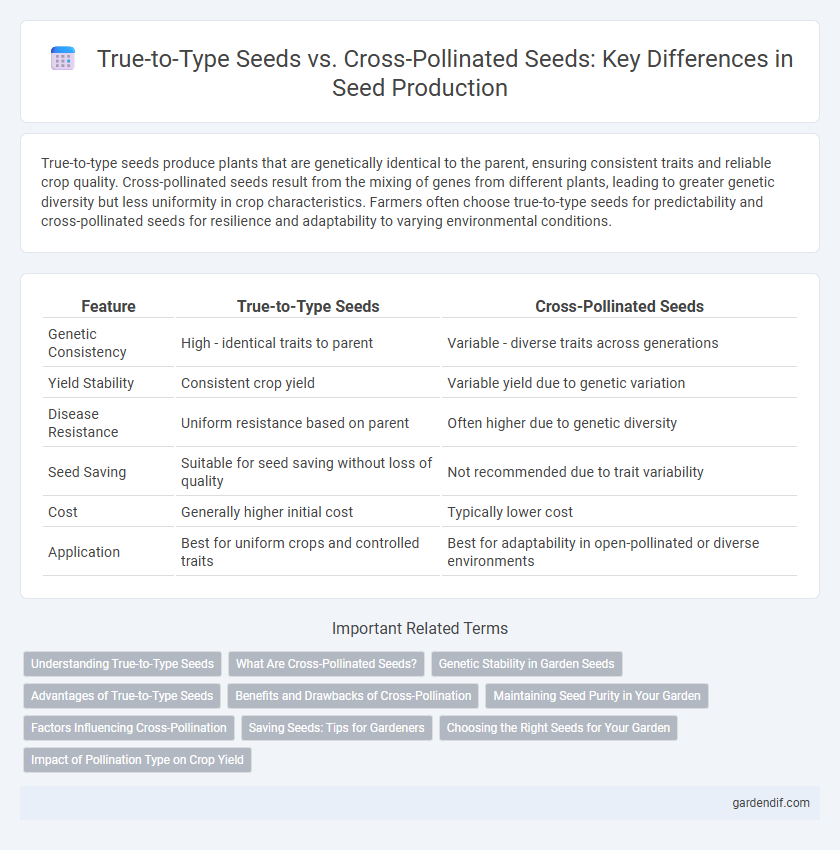
True-to-type seeds vs Cross-pollinated seeds Illustration
True-to-type seeds produce plants that are genetically identical to the parent, ensuring consistent traits and reliable crop quality. Cross-pollinated seeds result from the mixing of genes from different plants, leading to greater genetic diversity but less uniformity in crop characteristics. Farmers often choose true-to-type seeds for predictability and cross-pollinated seeds for resilience and adaptability to varying environmental conditions.
Table of Comparison
| Feature | True-to-Type Seeds | Cross-Pollinated Seeds |
|---|---|---|
| Genetic Consistency | High - identical traits to parent | Variable - diverse traits across generations |
| Yield Stability | Consistent crop yield | Variable yield due to genetic variation |
| Disease Resistance | Uniform resistance based on parent | Often higher due to genetic diversity |
| Seed Saving | Suitable for seed saving without loss of quality | Not recommended due to trait variability |
| Cost | Generally higher initial cost | Typically lower cost |
| Application | Best for uniform crops and controlled traits | Best for adaptability in open-pollinated or diverse environments |
Understanding True-to-Type Seeds
True-to-type seeds consistently produce plants that retain the exact genetic traits of the parent plant, ensuring uniformity in crop quality and characteristics. These seeds are typically derived from self-pollinated or controlled pollination processes, which maintain their genetic purity. Gardeners and farmers prefer true-to-type seeds when they aim for predictable plant performance and reliable harvest outcomes.
What Are Cross-Pollinated Seeds?
Cross-pollinated seeds result from the fertilization of a plant's ovules by pollen from a different individual, promoting genetic diversity and resilience in crops. These seeds often produce plants with varied traits, which can enhance adaptability to environmental stressors compared to true-to-type seeds. Farmers use cross-pollinated seeds to develop hybrid vigor, improving yield and disease resistance in agricultural production.
Genetic Stability in Garden Seeds
True-to-type seeds exhibit high genetic stability, ensuring offspring identical to the parent plant, which is crucial for maintaining specific traits in garden seeds. Cross-pollinated seeds result in greater genetic variation, leading to diverse phenotypes that may not consistently reproduce the desired traits. Gardeners seeking uniformity and predictable plant characteristics prefer true-to-type seeds for reliable crop quality and performance.
Advantages of True-to-Type Seeds
True-to-type seeds ensure genetic consistency, producing plants that exhibit uniform traits identical to the parent plant, which is crucial for maintaining crop quality and reliability. They offer predictable growth patterns and yield, simplifying management for farmers who require consistent products for market standards or seed saving purposes. These seeds are ideal for preserving heirloom varieties and supporting sustainable agriculture through maintaining biodiversity.
Benefits and Drawbacks of Cross-Pollination
Cross-pollinated seeds promote genetic diversity, enhancing plant resilience to diseases and environmental stress, which can lead to higher yields in variable conditions. However, they may produce offspring with variable traits, making them less predictable compared to true-to-type seeds, which consistently replicate parent characteristics. Farmers benefit from vigor and adaptability in cross-pollinated crops but face challenges in maintaining uniformity and seed saving.
Maintaining Seed Purity in Your Garden
True-to-type seeds preserve genetic consistency, ensuring plants grow with predictable traits, which maintains seed purity essential for stable crop quality in your garden. Cross-pollinated seeds result from genetic mixing, leading to variability that can compromise seed purity and may require controlled isolation or hand-pollination to preserve desired characteristics. Gardeners focused on maintaining seed purity prioritize true-to-type seeds to achieve uniformity and reliable performance in subsequent plant generations.
Factors Influencing Cross-Pollination
Cross-pollination in seeds is influenced by factors such as the proximity of different plant varieties, the presence and activity of pollinators like bees and wind, and the plant's flowering time overlap. Environmental conditions including temperature, humidity, and landscape can also impact the rate and success of cross-pollination. These factors affect genetic variability, making cross-pollinated seeds less true-to-type compared to self-pollinated seeds.
Saving Seeds: Tips for Gardeners
True-to-type seeds guarantee that plants grown from saved seeds will display the same traits as the parent, making them ideal for maintaining specific varieties. Cross-pollinated seeds require isolation techniques and controlled pollination to prevent genetic mixing and ensure seed purity during saving. Gardeners should label seed batches accurately, collect seeds only from healthy, vigorous plants, and store them in cool, dry conditions to preserve viability.
Choosing the Right Seeds for Your Garden
True-to-type seeds guarantee offspring identical to the parent plant, preserving specific desirable traits for consistent garden results. Cross-pollinated seeds offer genetic diversity, enhancing disease resistance and adaptability but with variable plant characteristics. Selecting the right seeds depends on whether gardeners prioritize uniformity or genetic variation to suit their garden's unique needs.
Impact of Pollination Type on Crop Yield
True-to-type seeds, produced through controlled self-pollination, ensure genetic uniformity and consistent crop traits, directly influencing reliable yield outcomes. Cross-pollinated seeds, derived from the mixing of diverse parent plants, often exhibit hybrid vigor, which can enhance overall crop yield and resilience against environmental stresses. The choice between true-to-type and cross-pollinated seeds fundamentally impacts yield stability and productivity, with cross-pollination typically promoting higher adaptability in varying conditions.
True-to-type seeds vs Cross-pollinated seeds Infographic

 gardendif.com
gardendif.com